The city should not fall, which is unfortunate because the city is in the process of falling. Oh, all was well there for a while: an egalitarian oasis among the glaciers, an icy plateau of organized labor, respect for the environment, and an aggressive equal pay policy where the lowest-ranking people got the same pay as our brightest scientists.
But the problem with socialism is that we eventually run out of coal? The problem is running out of coal. And then the problems begin. The ice I kept at bay infiltrated my infirmaries and nurseries, the machines that reproduced me stuttered and failed, and my subjects were divided into two groups: those who wanted my head, and those who were dead.
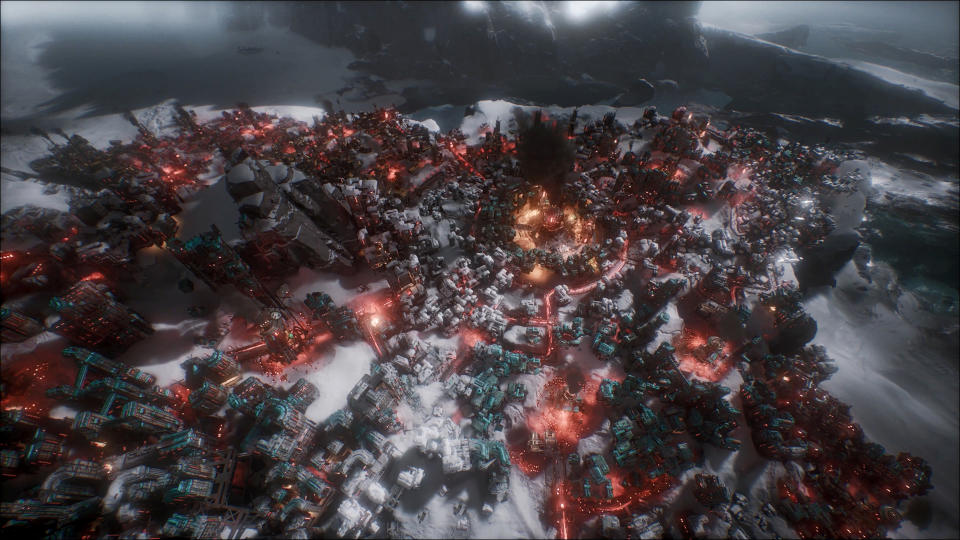
Frostpunk 2 is as unforgiving as its ancestor, but wait, it’s even harder. In the first game, your authority was almost unlimited. Making laws was a matter of decree: You waved your hand and whole new social orders emerged.
But these were the old days. At the time, you played the role of Captain, the undisputed master and commander of the post-snow apocalypse society of the First Frostpunk. The name of the game was “Whatever I say happens.”
But now the Captain is dead and you play his hand-picked successor, the Commissioner. Even worse: The mob has gotten involved with this dangerous new thing: democracy, It’s a massive conspiracy to make your job even harder, and doing things like adding sawdust to everyone’s daily meals or harvesting their organs after death now requires a long negotiation with city factions and a tense vote in parliament.
pure ideology
“Frostpunk 1 was an apocalyptic game where the world was ending,” says Frostpunk 2 co-director Jakub Stokalski. This was the question “how to survive in nature.” By the second game, where your city already begins as a sprawling metropolis, this question has largely been answered and the public is eagerly awaiting it. “These people, shaped by this ordeal, are now looking for a future for themselves… They begin to produce different ideas for this future, and they become disconnected from each other.”
“Your greatest enemy is not nature, but human nature.”


These “different ideas for the future” are implemented mechanically by the game’s faction and community system; Across the bottom of your screen is a series of headshots representing the many different perspectives of your society, tied to the binaries of Adaptation vs. Progress, Merit vs. Equality, and Reason vs. Tradition.
In my game – and I must emphasize this – never more was far away due to the ‘coal depletion’ event – these groups were split into Frostlanders (hard adapters), New Londoners (tech-driven advancement types) and the Stalwarts, the Captain’s former die-hard supporters who loved conquering the frosts with technology. and lashes out at anyone who thinks otherwise.
“These people, shaped by this ordeal, are now looking for a future for themselves.”
They all have their own opinions about you, and communities can spawn factions of smaller but more dedicated cadres determined to push certain ideologies or policies. I only encountered one while playing the game; a gang determined to roll back my policies and implement a more meritocratic society – but Stokalski assures me it can get “crowded” and “crazy” if you allow it, especially outside of the game’s story mode.
Anyway, who cares what the factions think? I knew from the beginning what my purpose was. A large target symbol declared that I had 523 weeks of coal left and that it was crucial that I find some kind of new energy source in the meantime. I also experienced a housing crisis and healthcare shortages, and a lack of consumer goods had created a crime epidemic on my streets.
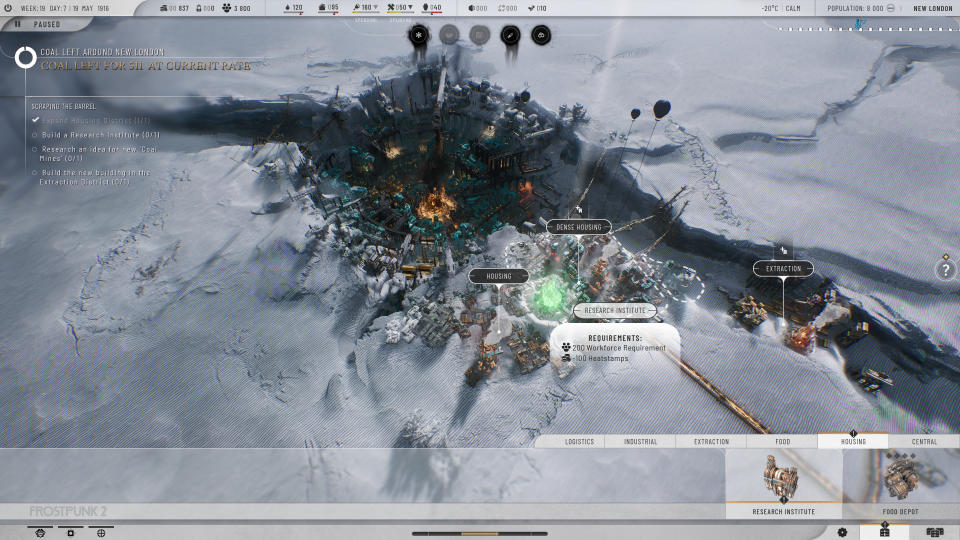

We play base
Everything was very clear: The conditions were ripe for Communism. Actually, it’s not just communism. Turbo-communism. A huge leap towards the final stage of history. A sparkling ice city where war and class are scary stories for children.
All I had to do was get my preferred policy package through parliament, which is where these communities and factions come into play. The seats (and votes) in Frostpunk 2’s parliament are occupied by these groups, and they all have their own views on various issues. laws you can suggest. My Parliament was split between about 10 Stalwarts, 40 or so Frostlanders, and over 50 New Londoners.
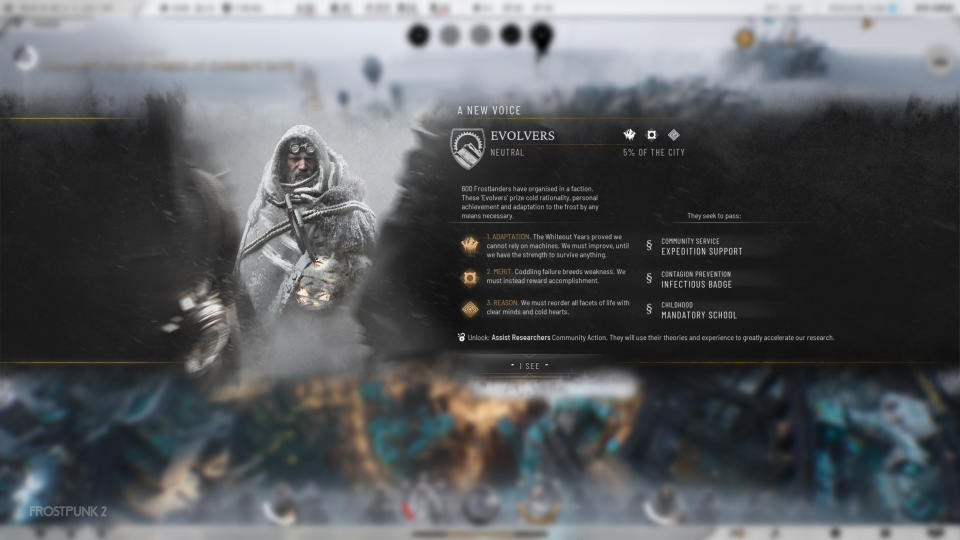

Inexplicably, none of them were keen on building the Fifth International. The laws I want to pass would ensure that everyone in my city has access to basic needs, regardless of whether they work, and that everyone who works made The same salary was earned in every job, from garbage collectors to doctors.
It was a riddle. brave men hated This. As meritocratic, progress-obsessed reactionaries, they viewed my plans for the city as an insidious communist plot, which was only two-thirds true. Luckily there were only 10 people there so it wasn’t worth the time to bother. They went to the dustbin of history.
The Frostlanders and New Londoners were trickier. Both were split roughly in half. When I checked the policy screen to check the passing potential of my bills, the predicted outcome was alarmingly uncertain: close to 20, close to 30, and everything else frustratingly indecisive. I could roll the dice if I wanted—I had passed other laws where the undecided ultimately ended in my favor—but this was the future of the human race we were talking about. I didn’t want to leave anything to chance.
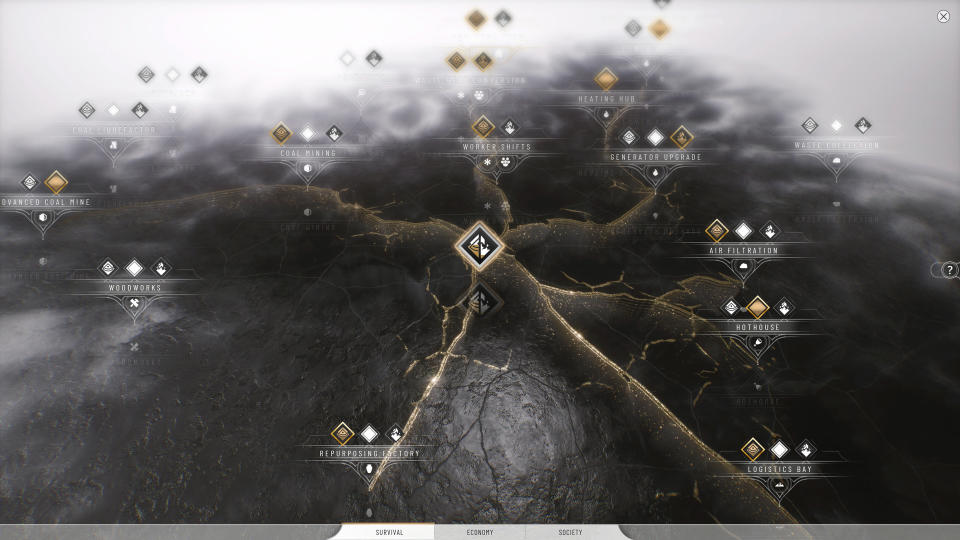

Now it was time to rejoice, Capitol Hill style. The Frostlanders already like me better than the New Londoners. This was due to Frostpunk 2’s new research system: Instead of progressing linearly through a tech tree, each community in your city offers various iterations of an idea, and you choose which one to go with. Up to this point, I had been inclined towards the more sustainable inventions of the Icelanders, and they had been curious about me in return.
So I made them a promise: in exchange for their support on the ice communism issue, I would pass a law they wanted – mandatory civilian support for our explorers in the wasteland – and so a deal was struck. The law passed easily, a new world was established, everyone lived happily ever after.
Iced
A little. You have to tell me this: Things went really well there for a while. Of course, the equal pay law set off a chain of events that caused the more administrative and bourgeois elements of my city to grumble and irritate, but people were—for the most part—quite happy under the new order.
But here’s the question: Is this the law I promised to pass for the Icelanders? Of course, not everyone was very keen on this. I had to renegotiate in Parliament, which meant more promises, which led to more promises, which led to more promises. As bad a politician as I am, I’ve actually moved heaven and earth to protect them all, and the simple process of keeping track of everything I’ve promised everyone has distracted me from the menial task of securing a new fuel source for our heaters.


Everyone was incredibly pleased with me and all my promises, which I kept until the coal ran out; In a way, I stopped paying attention to these things because I fell into the trap of political maneuvering and ideology. I’m not surprised; the game does a good job of not bombarding you with too much information and mechanical complexity, and Stokalski says this is a conscious effort on the part of the developers to ensure that you’re never “taking notes, doing math at the same time, just so you don’t die” – just without paying much attention to material reality. I was caught up in ideas.
So the generator breathed its last breath, piling up on our infrastructure, and all the happiness meters of the groups that were so happy with me turned angry, hollow red. It wasn’t long before I was kicked out of power and my beautiful, frozen soviet went the way of the Paris Commune.


But for a moment, a brief, bright moment, we had our sparkling city of ice.
After the doomsday
So Stokalski is right (I guess that’s not surprising considering he co-directed the game) Frostpunk 2 is a few steps ahead in Maslow’s hierarchy of needs. If the first game was about the post-apocalypse (the gathering of real needs for existence) this game is post-apocalyptic. HE. It’s about figuring out what the future will be after the entire world is destroyed, but even if the food and coal problems are solved for now, they’re always in danger of becoming problems again.
And so far? I’m in this business. From my time with the game, Frostpunk 2’s political elements feel like a natural evolution of the first game’s relatively primitive Discontent/Hope and Order/Belief systems, forcing you to consider not just what your citizens need, but what they want. Success is no longer just a matter of having enough food to survive graying, it is a much broader category. So is failure.
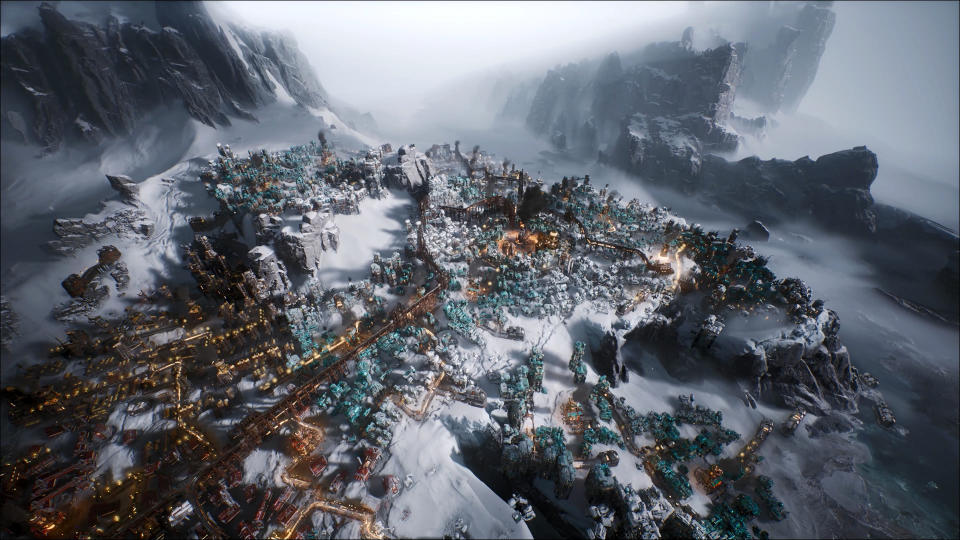

Frostpunk 2 launches on Steam, GOG and Epic on July 25th.